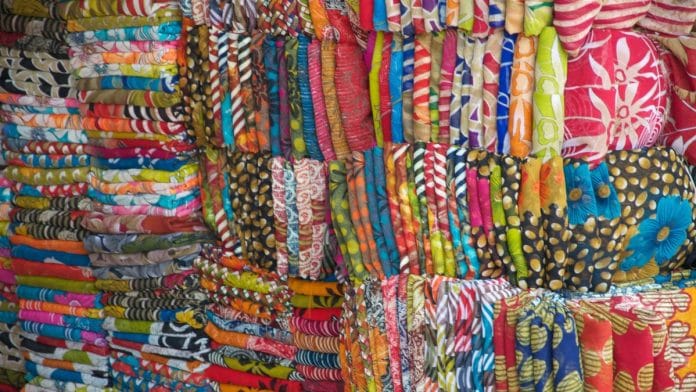New Delhi: Although India holds a global comparative advantage in cotton and cotton-based fibres, the world’s textile market has moved beyond these materials, the Economic Survey 2024-25 has highlighted. It states that currently, only 22 percent of the global textile market is cotton-based, while 77 percent is dominated by human-made fibres (MMF), according to International Cotton Association data.
The Economic Survey, presented in Parliament by Finance Minister Nirmala Sitharaman and prepared by Chief Economic Advisor V. Anantha Nageswaran, emphasises that this is a key reason why India’s textile sector has struggled to boost its export growth.
“India has a great opportunity to align with the evolving global shifts in apparel demand,” the Survey said. “While our comparative advantage lies in cotton and cotton-based products, global demand has shifted to products made from man-made fibre (MMF).”
It said that MMF-based products range from yoga pants and athleisure wear to technical textiles in aviation, aerospace, and automobiles.
“India’s share of global MMF production is currently 9.2 percent, and the potential to catch up with the production levels of global leaders like Vietnam, China, and Taiwan is high,” the survey noted. “By tapping into the MMF value chain, India will benefit from the steady rise in global MMF demand.”
In order to do this, the survey said, the government would need to ease business regulations pertaining to the sector and companies would be required to invest much more in research.
“To match the quality of our competition and reap value gains from MMF production, our MMF sector must move towards vertical integration and significantly invest in research and development and sustainable production techniques,” the survey said.
The survey noted several steps the government had already taken to boost innovation in the sector and also to promote vertical integration. However, it added that a lot more needed to be done.
“These objectives would require the industry to step up its research efforts and vertically integrate and tailor products to international quality and sustainability requirements,” the survey said.
Additionally, it said that “simplification, consolidation, and elimination of processes that consume the financial and managerial bandwidth of Indian exporters is a low-hanging fruit for its policymakers.”
“Addressing these challenges can significantly reduce costs and ease the burden on exporters, helping them become more efficient and competitive,” the survey added.
Also Read: As growth slows & capex falls, Economic Survey suggests prioritising ‘efficient’ investment
How India loses out to China & Vietnam
The survey made it a point to compare India’s textile sector to those in China and Vietnam to show how they differ in terms of products as well as the extent of regulations.
It noted that India’s textile production takes place across multiple independent and clustered small and medium enterprises (SMEs) spread across the country. It gave the example of cotton production, which is spread across Gujarat, Madhya Pradesh, and Andhra Pradesh.
“The fresh produce of cotton then travels down to Tamil Nadu, where cotton yarns are produced,” it explained. “The yarns then travel to parts of Maharashtra and Gujarat before being weaved into cotton fabric.”
The survey pointed out that a lack of localisation and the complexity of the value chain result in higher costs when compared to global competitors.
“In contrast, vertically integrated ‘fibre-to-fashion’ firms in competitor nations such as China and Vietnam export low-cost products, maintain consistent quality and are nimble enough to adjust to the fast-changing nature of the industry,” it said.
The survey also highlighted that “simple and liberal customs procedures in countries like China and Vietnam further reduce regulatory costs and lend a competitive edge to the exports of global textile competitors based in these countries.”
“On the other hand, in India textile exporters are constrained by complex procedures, which, for instance, require exporters to meticulously account for every square centimetre of fabric, buttons and zippers used,” it added.
“Similarly, pre-shipment inspection certificates are required for textile imports, which slows down logistics and raises costs for the textile business,” the survey said.
Further, the survey highlighted that the Indian textile sector faces an even more uphill task because countries like China and Vietnam benefit from free trade agreements (FTAs) signed with consumer countries.
“In effect, Indian apparel exports do not face a level playing field compared to its competition,” the survey said.
(Edited by Radifah Kabir)
Also Read: India to grow by 6.3-6.8 percent in FY26 : Economic Survey






